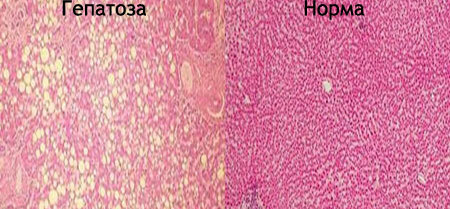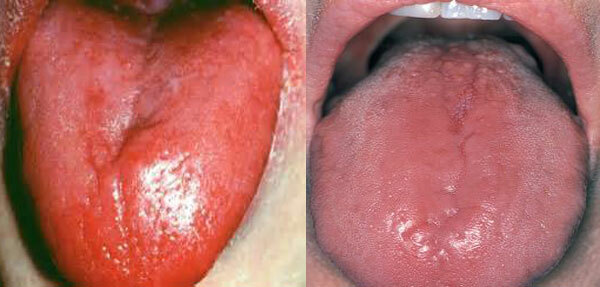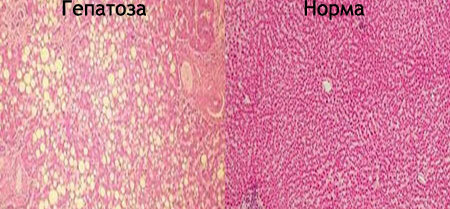One of the most common liver diseases that occurs asymptomatically in the initial stage. Treatment of fatty liver hepatosis, with the correct approach of the doctor and the patient, leads to a complete restoration of the functions of the body.
What happens in the body?
With fatty hepatosis, liver cells( hepatocytes) lose their functions, gradually accumulating simple fats and regenerating into adipose tissue. With steatosis or fatty infiltration, the fat mass exceeds 5%, its small clusters are scattered, so is the diffuse fatty liver hepatosis. With its content of more than 10% of the total weight of the liver, more than half of the hepatocytes contain fat.
Diffuse liver changes by the type of fatty hepatosis change the body consistency. In it local or scattered lesions are formed, consisting of the degenerated into fat cells.
At the initial stage, the pathology does not have symptoms that would cause the patient to consult a doctor. The use of maintenance drugs to restore the liver of Essentiale Forte or Phosphoglyph has no effect on steatosis and the process of organ degradation continues. From a certain moment the situation sharply goes out of control, then the organs begin to suffer, the functions of which depend on the work of the liver.
 There is a reaction, the liver does not get enough blood supply, and in the bloodstream the level of toxins rises - liver degradation accelerates. It is important not to skip this stage and begin immediate treatment, otherwise the process will become irreversible.
There is a reaction, the liver does not get enough blood supply, and in the bloodstream the level of toxins rises - liver degradation accelerates. It is important not to skip this stage and begin immediate treatment, otherwise the process will become irreversible.
Contents
- 1 Causes of fatty liver hepatosis
- 2 Symptoms of fatty liver hepatosis
- 3 Treatment of fatty liver hepatic disease, diet and preparations
- 3.1 Diet for fatty liver hepatosis
- 3.2 Folk remedies for liver hepatosis
- 4 Prevention of hepatosis
Causes of fatty liver hepatosis
Changes in livercan be divided into the stage of fatty hepatosis. Initially, there are some disorders associated with improper metabolism and hormonal changes in the body.
Hepatocytes begin to accumulate fatty acids( lipids), due to their excessive intake from food or the accelerated splitting of fats in the tissues of the body. Then the liver cells die, replaced by a fibrous tissue, and completely lose their functions.
Patients who have problems are at risk:
- with excess weight, localization of fat in the abdomen;
- are insulin resistant;
- with elevated cholesterol;
- with arterial pressure above 130/80 mm Hg.p.
- with diabetes mellitus type II.
Among the contributing factors, the following can be distinguished:
- viral hepatitis type B and C;
- Alcohol consumption;
- improper diet;
- diabetes;
- obesity;
- deficiency in the diet of protein and vitamins;
- work related to chemicals;
- heredity;
- sedentary lifestyle;
- excess of hepatic enzymes;
- reception of preparations of a nonsteroid group, antibiotics and hormones.
Fatty hepatosis increases the risk of diabetes and cardiovascular disease. Almost 90% of obese patients have fatty hepatosis.
The liver is able to restore its functions, it is important not to miss the moment when the process can still be affected.
Symptoms of fatty liver hepatic

In the initial stage of fatty liver hepatosis, symptoms are completely absent. Later there is discomfort, a feeling of heaviness in the right hypochondrium, fatigue, a slight icterus of the skin. The liver is enlarged and palpated, the patient feels pain.
ultrasound accurately determines the size of the organ and how far the original boundaries of the location are exceeded. A blood test shows an elevated level of aminotransferase, cholesterol.
The amount of fibrous tissue in the liver serves to determine the severity of the disease. There are 4 stages, at "0" it is a healthy organ, and the fourth stage is developed cirrhosis of the liver.
There are risk factors for the formation of fatty hepatosis, among them:
- high blood pressure;
- female gender;
- reduced platelets;
- elevated alkaline phosphatase and GTG;
- polymorphism of the PNPLA3 / 148M gene.
Treatment of fatty liver hepatosis, diet and drugs
Obvious symptoms appear when the disease progresses and therefore treatment of fatty liver hepatosis must begin immediately. First of all, eliminate or reduce the harmful effects of factors that adversely affect the body - it is forbidden to drink alcohol, fatty foods. The nutritionist makes an approximate menu for the entire period of therapy.
For successful treatment it is necessary to change not only the diet. The patient will need to revise his lifestyle and increase physical activity aimed at reducing weight, reducing stagnation in internal organs, increasing sensitivity to insulin.
Diet for fatty liver hepatosis involves an increase in protein foods of plant origin, reducing or eliminating refractory fats and fast carbohydrates. Fasting is excluded. Eating at least four times a day. Aerobic exercise will allow moderately reduce body weight. The norm is a weight loss of not more than 1000 g per week. If the weight is reduced faster - it will worsen the clinical picture.
Medical treatment of fatty hepatosis includes drugs that increase the sensitivity of the body to insulin. Necessarily appoint hepatoprotectors( Essentiale forte, Syrepar), vitamins B12, folic acid and antioxidants.
- Recovery of the liver is impossible without a properly formulated diet.
Diet for fatty liver hepatosis
The diet is developed by the doctor taking into account the indications of the patient's tests. An exemplary menu is made, which will allow to remove from the diet "harmful" products. This will promote the normal functioning of the liver, restore the metabolism of fats and reduce cholesterol.
The glycogen level is gradually leveled, the formation of glucose is normalized for the normal functioning of the internal organs. The diet promotes the normal separation of bile for the digestive process.
The main aspects of the diet for fatty hepatosis:
- Regular food intake.
- Refusal of alcohol and smoking.
- The exception of fried and fatty.
- Decrease in salt intake.
- Regular drinking regime.
- Cook with boiled, steam method.
Fish and meat dishes should be baked or stewed. Do not eat offal, rich in purines. Refuse from spicy seasonings, garlic and marinades. Preference is given to low-fat dairy products, low-fat cottage cheese. Exclude carbonated sweet drinks. The basis of the diet is lean soups, cabbage soup. Baked vegetables, lean fish and meat. Pure cheese, steamed omelettes, boiled eggs are allowed. For breakfast prepare porridge and casseroles.
Folk remedies for liver hepatosis
Better to combine diet and drug treatment of fatty liver hepatosis with folk remedies.
Repeatedly proven the positive effect of eating pumpkin. This vegetable protects the liver and helps cells to recover faster.
For this, pumpkin honey is prepared. Recipe: the ripe fruit is cut off the lid and scrub the seeds. Fill up to the brim with honey, return the lid to the place, leave the pumpkin to infuse for 2 weeks at room temperature. Then honey is poured into a clean dry jar and stored in a refrigerator. When hepatitis take 1 tablespoon 3 times a day.
From medicinal herbs prepare infusions and decoctions. Recipes will not be given - this requires agreement with the attending physician.
Prevention of hepatosis
- Timely to treat and prevent diseases of the gastrointestinal tract.
- Responsible for the diet, do not overeat.
- Avoid alcohol, mindless use of medicines.
- Take medications to maintain liver function.
The liver is able to take care of itself, if a person does not forget to pay attention to it. It is a unique organ and filter that preserves the health of our body and cleans from toxins. Simple techniques help to keep the liver healthy or restore it in pathological processes.
Fat hepatosis is not a sentence, if the patient wants to cope with the disease, then making an effort, he will succeed. It is important to follow the doctor's instructions and not to violate the prescriptions.



